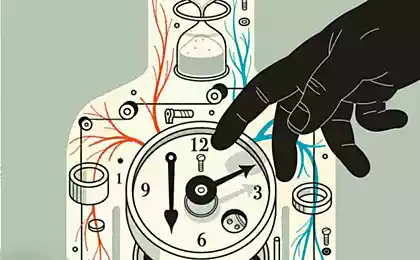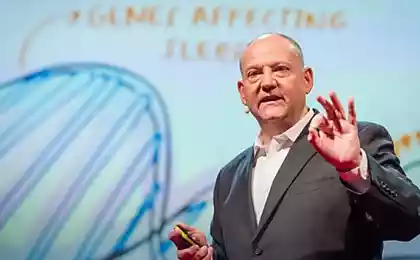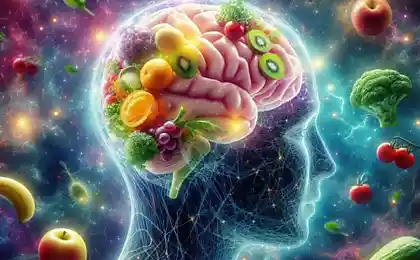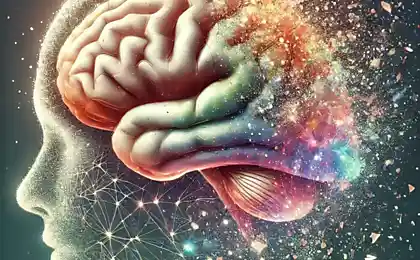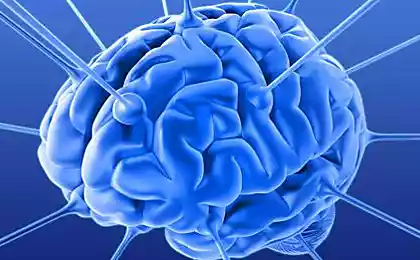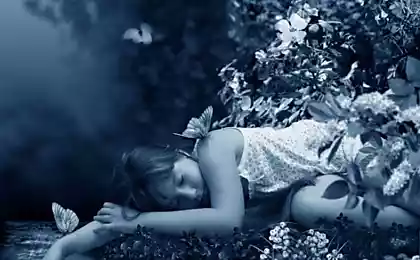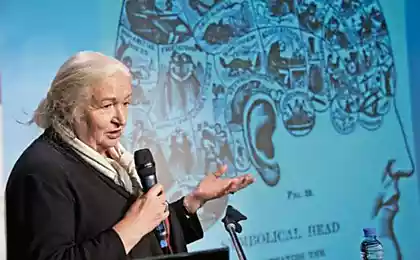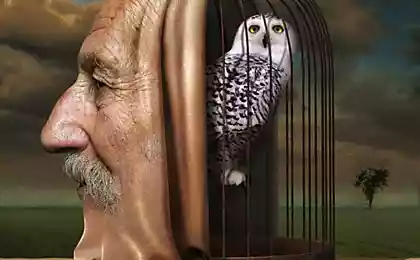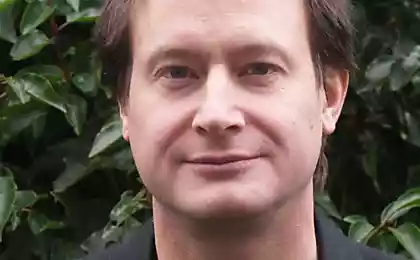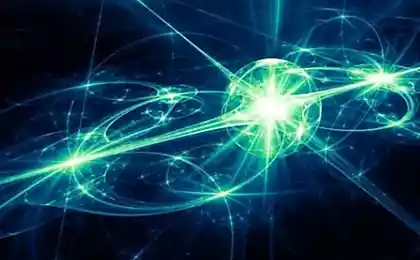697
Jürgen Zulli: Sleep is not peace, it is another Wake
You Wake up, stretch out sweetly in a soft bed, get up and see through the huge window, the sun rising over the surface of the ocean, white sand beach and palm trees. Through the open door of the loggia blowing fresh sea breeze and heard the sound of the surf. You drink flavored ground coffee out of doors two-storey villas, get in the car with a rearing horse on the hood, turn the key, and under the noble rumble of the V8 engine... finally Wake up from alarm bells.
Again a treacherous brain made us believe in the reality of the situation. But how does he do it? How manages to force a person to lie almost motionless for seven hours or more, while showing interesting action with a thrilling story?
The reason for this is a complex biochemical process, involving not just one or two structures of the brain, and the whole network. How does the interaction and switching Wake on sleep? How is sleep and when come dreams? Why sometimes, waking up from the alarm, we feel able to move mountains, and sometimes angrily, ready to destroy everything around?

Through a veil of time
Somnology is the scientific study of sleep — appeared relatively recently, for the age of the first fundamental research in the area of the "realm of Morpheus" does not exceed 120 years. Before this dream was given mystical significance, as a border state between life and death. Aristotle said: "Sleep, apparently, belongs by its nature to such as, for example, the border between life and not life, and sleep and there isn't quite exist."
The great physician of antiquity Hippocrates believed that sleep occurs as a result of the outflow of blood and heat from the head to the inner parts of the body. This explanation owned the minds of European scientists and was taken on faith for almost two thousand years. In one Hippocrates was right: the reasons for the immersion of a person into the world of dreams had to look in my head.
And then came the twentieth century. In Germany, in the clinic of Professor strumpell's patient arrives partially lost as a result of injuries to sight and hearing, is deaf in one ear and blind in one eye. Doctors noticed that, when the two remaining "Windows to the world" were closed, the patient fell asleep.
The famous physiologist Pavlov became interested in these observations and decided to conduct similar experiments on their favorite players — dogs. He found that if we exclude the constant inflow of impulses from sense organs to the cerebral cortex, there comes a dream. A scientist investigated the impact of monotonous stimuli, repeatedly repeating a light touch to the skin of the hips hind legs.
They are almost always euthanized animals, and this gave the researcher the right to believe that sleep is a widespread in the cortex of conditional inhibition, which is intended to protect the brain of dogs from too frequent repetition of any irritation.
The next step in overcoming the mysteries of the dream was the emergence of a method of electroencephalography (EEG). In 1905, the German physiologist Hans Berger recorded for the first time that the person who is in a relaxed state with eyes closed, a sinusoidal electric potential with a frequency of 8-11 Hz, most pronounced in the occipital areas of the brain. These fluctuations have been called the alpha rhythm.
In the 1930s the situation has a little cleared up: researchers cut the brain stem of the cat at the level of the midbrain, called the animal to whom — as, like a dream. While the cat's EEG was observed a slow electric oscillations, which was later called "sleep spindles" (figure was reminiscent of one side of the spindle).
When the brain was cut at the level of the first cervical segments, separating the spinal cord from the head, managed to obtain the so-called drug the waking brain: the cat he watched her moving in front of objects, and the EEG showed oscillations with a frequency of 14-30 Hz (beta rhythm). It became clear that in the brain of animals have different structures — responsible for sleep and is responsible for awakening.
The center of vitality
The structure of the brain stem of the cat, responsible for the state of wakefulness, described in the late XIX century Vladimir Bekhterev and Santiago Ramon and Cajal, who saw a scattered cluster of neurons permeated by nerve fibers, in the middle of the brain stem.
But why this formation, the Italian neuroscientist Giuseppe Moruzzi and American neurologist Horace Magoon established only in the second half of the twentieth century. They called this structure the reticular formation ("reticule" in Latin means "network"). It is in the brain stem are the kernel, which concentrated in itself all the impulses from the sensory receptors going to the brain.
Long processes (axons) of neurons of the reticular formation are connected with the cortex and with the neurons of the spinal cord. In the reticular formation are also nerve fibers from the cortex and from the spinal cord in a complex system with feedback. Signals from the reticular formation (reticular level) trigger the mechanisms of wakefulness in the cerebral cortex, and the cortex, in turn, controls the state of the reticular formation.
The casket with sleep
In 1990, screens out the film "the Awakening", filmed on the eponymous book of memoirs, the famous psychiatrist Oliver sacks. He talks about a strange group of 80 elderly patients, for more than 40 years suffering from an unknown disease resembling autism or Parkinson's disease. Patients Sachs was the last remaining living victims of a mysterious epidemic that suddenly began in Europe in the winter of 1916-1917, and then spreading to the whole world and claimed in the period after the First world war the lives of 5 million people.
Sick was plunged into sudden apathy and suffered from high temperature, impaired vision, and hallucinations. Then the disease passed into a chronic form and was accompanied by a huge variety of clinical manifestations. But all forms was a common sleep disorder. This fact seemed interesting Viennese neurologist, Baron Constantin von Economo.
He found that some patients sleep too much, weeks, months, waking only to drink and eat, while others completely lost the dream. At the autopsy, the scientist found similar anatomical pattern: at a certain section of the intermediate brain patients had massive death of nerve cells.
This area of the brain called the hypothalamus, as it is located under the thalamus — a brain area, which redistributes the signals from the senses. If we were able to insert your index finger right in the head at the bridge, would then have rested it in the hole where it is, — "Turkish saddle".
The hypothalamus is one of the most important centers that control vegetative nervous system regulates, inter alia, body temperature, blood pressure, appetite, sexual need and lust. All of this Economic and, of course, did not know. However, he suspected that there must be a center that controls sleep. "Apparently, concluded the researcher, these cells are doing something, so we fall asleep".
Now, thanks to the research of Clifford Saper of Harvard University in Boston became known that the hypothalamus really is a special plot which aktiviziruyutsya when falling asleep, — ventrolateral preoptičeskoj region (VLPO). Axons of neurons from VLPO go down, in areas that support wakefulness. Conversely, not to keep us awake, the centre of vitality need to have a link with the hypothalamus, so that nerve fibers go from the bottom up.
Saper and his colleagues made the following conclusion: cells in the anterior part of the hypothalamus represent the centre of sleep, who with the help of their axons suppresses wakefulness centers in the brainstem, including midbrain and brain bridge. This process ultimately leads to falling asleep.
"Perhaps this is the key to the entire mechanism through the hypothalamus controls sleep and wakefulness," wrote neurologist. So in 2005, appeared the modern concept of sleep, which Saper published in his article in the journal Nature. According to this concept, the whole "sleep system" is a network of multiple interconnected nodes that are activated in a special way at certain times and regulating sleep and wakefulness.
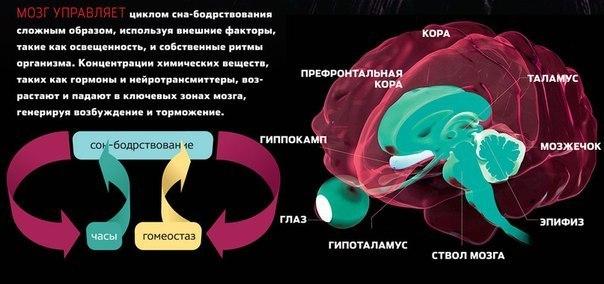
Brain confrontation
The first part of the common system "sleep-Wake" — braking system. This VLPO in the anterior hypothalamus, from which the system of wakefulness sent a wave of inhibition, and this leads to the translation of the brain in "sleep mode". From the point of view of biochemistry home "brake fluid" of the system is gamma-aminobutyric acid (GABA). By acting on special receptors, it inhibits the activity of neurons.
GABA-a receptor is a channel in the cell membrane, surrounded by large protein molecules that can change their spatial structure (relatively speaking, "to unfold" or "fold"). Upon binding of GABA with receptors on the lumen of the channel increases, it passes through more chlorine ions, which leads to a decrease in the electrical conductivity of the cell membrane makes it less sensitive to electrical influences. And this leads to inhibition of impulse activity — cell "reduces speed" frisky "gallop" to the quiet "step".
The second part of the system is the excitation system, which is based on the eight nerve ganglions, forming two parallel beam. Them of the excitation wave is conducted to the cerebral cortex. One beam starts in the reticular formation (the brain stem), the other in the so-called blue spot (Locus coeruleus). Here cells produce much of the total available in the brain stimulating the neurotransmitter norepinephrine. The region is responsible for the emergence of fear and panic, and for a significant portion of our excitement.
There are other neurotransmitters (dopamine, serotonin, and others), but they are linked to other processes in the brain. However, there is one specific carotid neurotransmitter. In a sideways (lateral) hypothalamus is several tens of thousands of nerve cells that produce a particular neurotransmitter orexin (hypocretin). This substance biochemists identified only in 1998. If orexin is too small, or if the brain is not enough relevant molecules-receptors, there is a rare condition — narcolepsy, which is characterized by sudden attacks of drowsiness and sleep.
Day, night — day off
However, this is only part of the mechanism of sleep. As with all wildlife, people live in accordance with their own internal rhythms, which are tied to the cycles of day and night. There are times when a person is predisposed to sleep, and there is a time for active work. The body has a "biological clock" — melatoninonline system. The main players in it — the supra nucleus of the hypothalamus and the pineal body (epiphysis), located in the intermediate part of the brain.
When the retina receives light information about this is in the supra nucleus of the hypothalamus (the small clock), and then, after passing a long way, gets in the pineal body, or the so-called third eye, which serves many animals, for example reptiles and birds, the detector light level. In humans, the evolution of the large hemispheres of the brain have increased significantly, closing the epiphysis, and he lost touch with the light. Nature had to "invent" the whole complex and the existing way of regulation of the synthesis of the "sleep" hormone.
The pineal gland produces melatonin — the hormone of the night and darkness. When the evening reduces the light level begins to produce melatonin, the cells transmitting the signal of "the end of the day". Its main function is braking effect on the supra core through which the activation of waking systems.
This process can be compared with the operation of the thermostat in the fridge a certain temperature. The longer we live an active life, the more strength the center of falling asleep feels the need to flip the switch for sleep. The longer we sleep, the less the need for sleep, so at some point, the system of wakefulness takes over and we Wake up and feel rested.
This model is called two-factor regulation, and developed it in 1982 head of the Department of psychopharmacology and sleep medicine at the University of Zurich Alexander Borbély. According to it, our need for sleep at a particular time is the result of the interaction of chronobiological and homeostatic (maintenance of internal equilibrium) factors. These components are scientist called process S and process C. Process S is the homeostatic component of the sleep requirements and the process — the impact of the internal clock, the main task — to leave for a long sleep it night.
"The process S, on the contrary, hourglass, says Borbely. — During wakefulness sand poured from the top into the bottom container, when falling asleep watch turn over". So for feel-good holiday is not only important how much time in a row we slept, but how much time we spent during the day to form a component of the S. And it has a good practical application known to many: if you know that the next night you cannot sleep, you can try to sleep in advance in the middle of the day. And then you will feel much better.
The relationship of teeth with the endocrine system and the spine
Why not a sneeze
And this is only a superficial look at the system responsible for sleep. Says the sleep from Regensburg jürgen Zulli, "sleep is not peace, it's more vigil".
Network regulation of sleep functions as a trigger without intermediate positions. Such a mechanism is possible due to the interlock centers of sleep and waking. As soon as one side gets the advantage, the whole system instantly switches to the opposite state. So she could not be switched constantly back and forth, orexin stimulates all centers of wakefulness, without suppressing the sleep center.
This imbalance complicates the switch just so that we relatively rarely passed from sleep to wakefulness and Vice versa. To transition to sleep it is necessary that the excitation system is weakened and the activity center for sleep increased. This slow process is familiar to everyone as the gradually increasing fatigue.published
Source: vk.com/mymozgi?w=wall-46553394_102477
Again a treacherous brain made us believe in the reality of the situation. But how does he do it? How manages to force a person to lie almost motionless for seven hours or more, while showing interesting action with a thrilling story?
The reason for this is a complex biochemical process, involving not just one or two structures of the brain, and the whole network. How does the interaction and switching Wake on sleep? How is sleep and when come dreams? Why sometimes, waking up from the alarm, we feel able to move mountains, and sometimes angrily, ready to destroy everything around?

Through a veil of time
Somnology is the scientific study of sleep — appeared relatively recently, for the age of the first fundamental research in the area of the "realm of Morpheus" does not exceed 120 years. Before this dream was given mystical significance, as a border state between life and death. Aristotle said: "Sleep, apparently, belongs by its nature to such as, for example, the border between life and not life, and sleep and there isn't quite exist."
The great physician of antiquity Hippocrates believed that sleep occurs as a result of the outflow of blood and heat from the head to the inner parts of the body. This explanation owned the minds of European scientists and was taken on faith for almost two thousand years. In one Hippocrates was right: the reasons for the immersion of a person into the world of dreams had to look in my head.
And then came the twentieth century. In Germany, in the clinic of Professor strumpell's patient arrives partially lost as a result of injuries to sight and hearing, is deaf in one ear and blind in one eye. Doctors noticed that, when the two remaining "Windows to the world" were closed, the patient fell asleep.
The famous physiologist Pavlov became interested in these observations and decided to conduct similar experiments on their favorite players — dogs. He found that if we exclude the constant inflow of impulses from sense organs to the cerebral cortex, there comes a dream. A scientist investigated the impact of monotonous stimuli, repeatedly repeating a light touch to the skin of the hips hind legs.
They are almost always euthanized animals, and this gave the researcher the right to believe that sleep is a widespread in the cortex of conditional inhibition, which is intended to protect the brain of dogs from too frequent repetition of any irritation.
The next step in overcoming the mysteries of the dream was the emergence of a method of electroencephalography (EEG). In 1905, the German physiologist Hans Berger recorded for the first time that the person who is in a relaxed state with eyes closed, a sinusoidal electric potential with a frequency of 8-11 Hz, most pronounced in the occipital areas of the brain. These fluctuations have been called the alpha rhythm.
In the 1930s the situation has a little cleared up: researchers cut the brain stem of the cat at the level of the midbrain, called the animal to whom — as, like a dream. While the cat's EEG was observed a slow electric oscillations, which was later called "sleep spindles" (figure was reminiscent of one side of the spindle).
When the brain was cut at the level of the first cervical segments, separating the spinal cord from the head, managed to obtain the so-called drug the waking brain: the cat he watched her moving in front of objects, and the EEG showed oscillations with a frequency of 14-30 Hz (beta rhythm). It became clear that in the brain of animals have different structures — responsible for sleep and is responsible for awakening.
The center of vitality
The structure of the brain stem of the cat, responsible for the state of wakefulness, described in the late XIX century Vladimir Bekhterev and Santiago Ramon and Cajal, who saw a scattered cluster of neurons permeated by nerve fibers, in the middle of the brain stem.
But why this formation, the Italian neuroscientist Giuseppe Moruzzi and American neurologist Horace Magoon established only in the second half of the twentieth century. They called this structure the reticular formation ("reticule" in Latin means "network"). It is in the brain stem are the kernel, which concentrated in itself all the impulses from the sensory receptors going to the brain.
Long processes (axons) of neurons of the reticular formation are connected with the cortex and with the neurons of the spinal cord. In the reticular formation are also nerve fibers from the cortex and from the spinal cord in a complex system with feedback. Signals from the reticular formation (reticular level) trigger the mechanisms of wakefulness in the cerebral cortex, and the cortex, in turn, controls the state of the reticular formation.
The casket with sleep
In 1990, screens out the film "the Awakening", filmed on the eponymous book of memoirs, the famous psychiatrist Oliver sacks. He talks about a strange group of 80 elderly patients, for more than 40 years suffering from an unknown disease resembling autism or Parkinson's disease. Patients Sachs was the last remaining living victims of a mysterious epidemic that suddenly began in Europe in the winter of 1916-1917, and then spreading to the whole world and claimed in the period after the First world war the lives of 5 million people.
Sick was plunged into sudden apathy and suffered from high temperature, impaired vision, and hallucinations. Then the disease passed into a chronic form and was accompanied by a huge variety of clinical manifestations. But all forms was a common sleep disorder. This fact seemed interesting Viennese neurologist, Baron Constantin von Economo.
He found that some patients sleep too much, weeks, months, waking only to drink and eat, while others completely lost the dream. At the autopsy, the scientist found similar anatomical pattern: at a certain section of the intermediate brain patients had massive death of nerve cells.
This area of the brain called the hypothalamus, as it is located under the thalamus — a brain area, which redistributes the signals from the senses. If we were able to insert your index finger right in the head at the bridge, would then have rested it in the hole where it is, — "Turkish saddle".
The hypothalamus is one of the most important centers that control vegetative nervous system regulates, inter alia, body temperature, blood pressure, appetite, sexual need and lust. All of this Economic and, of course, did not know. However, he suspected that there must be a center that controls sleep. "Apparently, concluded the researcher, these cells are doing something, so we fall asleep".
Now, thanks to the research of Clifford Saper of Harvard University in Boston became known that the hypothalamus really is a special plot which aktiviziruyutsya when falling asleep, — ventrolateral preoptičeskoj region (VLPO). Axons of neurons from VLPO go down, in areas that support wakefulness. Conversely, not to keep us awake, the centre of vitality need to have a link with the hypothalamus, so that nerve fibers go from the bottom up.
Saper and his colleagues made the following conclusion: cells in the anterior part of the hypothalamus represent the centre of sleep, who with the help of their axons suppresses wakefulness centers in the brainstem, including midbrain and brain bridge. This process ultimately leads to falling asleep.
"Perhaps this is the key to the entire mechanism through the hypothalamus controls sleep and wakefulness," wrote neurologist. So in 2005, appeared the modern concept of sleep, which Saper published in his article in the journal Nature. According to this concept, the whole "sleep system" is a network of multiple interconnected nodes that are activated in a special way at certain times and regulating sleep and wakefulness.

Brain confrontation
The first part of the common system "sleep-Wake" — braking system. This VLPO in the anterior hypothalamus, from which the system of wakefulness sent a wave of inhibition, and this leads to the translation of the brain in "sleep mode". From the point of view of biochemistry home "brake fluid" of the system is gamma-aminobutyric acid (GABA). By acting on special receptors, it inhibits the activity of neurons.
GABA-a receptor is a channel in the cell membrane, surrounded by large protein molecules that can change their spatial structure (relatively speaking, "to unfold" or "fold"). Upon binding of GABA with receptors on the lumen of the channel increases, it passes through more chlorine ions, which leads to a decrease in the electrical conductivity of the cell membrane makes it less sensitive to electrical influences. And this leads to inhibition of impulse activity — cell "reduces speed" frisky "gallop" to the quiet "step".
The second part of the system is the excitation system, which is based on the eight nerve ganglions, forming two parallel beam. Them of the excitation wave is conducted to the cerebral cortex. One beam starts in the reticular formation (the brain stem), the other in the so-called blue spot (Locus coeruleus). Here cells produce much of the total available in the brain stimulating the neurotransmitter norepinephrine. The region is responsible for the emergence of fear and panic, and for a significant portion of our excitement.
There are other neurotransmitters (dopamine, serotonin, and others), but they are linked to other processes in the brain. However, there is one specific carotid neurotransmitter. In a sideways (lateral) hypothalamus is several tens of thousands of nerve cells that produce a particular neurotransmitter orexin (hypocretin). This substance biochemists identified only in 1998. If orexin is too small, or if the brain is not enough relevant molecules-receptors, there is a rare condition — narcolepsy, which is characterized by sudden attacks of drowsiness and sleep.
Day, night — day off
However, this is only part of the mechanism of sleep. As with all wildlife, people live in accordance with their own internal rhythms, which are tied to the cycles of day and night. There are times when a person is predisposed to sleep, and there is a time for active work. The body has a "biological clock" — melatoninonline system. The main players in it — the supra nucleus of the hypothalamus and the pineal body (epiphysis), located in the intermediate part of the brain.
When the retina receives light information about this is in the supra nucleus of the hypothalamus (the small clock), and then, after passing a long way, gets in the pineal body, or the so-called third eye, which serves many animals, for example reptiles and birds, the detector light level. In humans, the evolution of the large hemispheres of the brain have increased significantly, closing the epiphysis, and he lost touch with the light. Nature had to "invent" the whole complex and the existing way of regulation of the synthesis of the "sleep" hormone.
The pineal gland produces melatonin — the hormone of the night and darkness. When the evening reduces the light level begins to produce melatonin, the cells transmitting the signal of "the end of the day". Its main function is braking effect on the supra core through which the activation of waking systems.
This process can be compared with the operation of the thermostat in the fridge a certain temperature. The longer we live an active life, the more strength the center of falling asleep feels the need to flip the switch for sleep. The longer we sleep, the less the need for sleep, so at some point, the system of wakefulness takes over and we Wake up and feel rested.
This model is called two-factor regulation, and developed it in 1982 head of the Department of psychopharmacology and sleep medicine at the University of Zurich Alexander Borbély. According to it, our need for sleep at a particular time is the result of the interaction of chronobiological and homeostatic (maintenance of internal equilibrium) factors. These components are scientist called process S and process C. Process S is the homeostatic component of the sleep requirements and the process — the impact of the internal clock, the main task — to leave for a long sleep it night.
"The process S, on the contrary, hourglass, says Borbely. — During wakefulness sand poured from the top into the bottom container, when falling asleep watch turn over". So for feel-good holiday is not only important how much time in a row we slept, but how much time we spent during the day to form a component of the S. And it has a good practical application known to many: if you know that the next night you cannot sleep, you can try to sleep in advance in the middle of the day. And then you will feel much better.
The relationship of teeth with the endocrine system and the spine
Why not a sneeze
And this is only a superficial look at the system responsible for sleep. Says the sleep from Regensburg jürgen Zulli, "sleep is not peace, it's more vigil".
Network regulation of sleep functions as a trigger without intermediate positions. Such a mechanism is possible due to the interlock centers of sleep and waking. As soon as one side gets the advantage, the whole system instantly switches to the opposite state. So she could not be switched constantly back and forth, orexin stimulates all centers of wakefulness, without suppressing the sleep center.
This imbalance complicates the switch just so that we relatively rarely passed from sleep to wakefulness and Vice versa. To transition to sleep it is necessary that the excitation system is weakened and the activity center for sleep increased. This slow process is familiar to everyone as the gradually increasing fatigue.published
Source: vk.com/mymozgi?w=wall-46553394_102477
